A Smart System for Continuous Sitting Posture Monitoring, Assessment, and Personalized Feedback
Abstract
1. Introduction
1.1. Background and Motivation
1.2. Research Objectives
2. Related Works
2.1. Sensors
2.2. Machine Learning Algorithms
2.2.1. Decision Tree (DT)
2.2.2. Random Forest (RF)
2.2.3. Support Vector Machine (SVM)
2.2.4. K-Nearest Neighbor (KNN)
2.2.5. Convolutional Neural Networks (CNN)
2.3. Feedback Mechanisms
2.4. Research Gap and Contributions
3. Methods and Design
3.1. Design Requirements and System Architecture
3.2. Hardware Design
3.3. Data Collection
3.3.1. Experimentation Setup
3.3.2. User-Centric Approach in Data Collection
3.4. Development of a Personalized Machine Learning Model
3.4.1. Data Augmentation
3.4.2. CNN Architecture for Posture Classification
3.4.3. Other Machine Learning Algorithms for Posture Classification
3.4.4. Training and Validation Approach
3.5. Postural Feedback Techniques
3.5.1. Personalized Feedback Using LLM
3.5.2. Postural Assessment Using Borg CR-10 Scale
3.5.3. Sitting Posture Quality Assessment
3.6. SitWell Feedback Platform
4. Results and Discussion
4.1. Performance of the Machine Learning Algorithms
4.2. The Performance Results for CNN
4.3. Comparison Between the Pressure Sensor Density and Machine Learning Model Accuracy
4.4. Cost-Effectiveness of Pressure Sensing Technologies
4.5. Evaluation of AI Recommendation
5. Conclusions
6. Future Directions
Author Contributions
Funding
Institutional Review Board Statement
Informed Consent Statement
Data Availability Statement
Acknowledgments
Conflicts of Interest
References
- Daneshmandi, H.; Choobineh, A.; Ghaem, H.; Karimi, M. Adverse Effects of Prolonged Sitting Behavior on the General Health of Office Workers. J. Lifestyle Med. 2017, 7, 69–75. [Google Scholar] [CrossRef] [PubMed]
- Keskin, Y. Correlation between Sitting Duration and Position and Lumbar Pain among Office Workers. Haydarpasa Numune Med. J. 2019, 61, 1–6. [Google Scholar] [CrossRef]
- Global Status Report on Physical Activity 2022. Available online: https://www.who.int/publications/i/item/9789240059153 (accessed on 5 July 2025).
- Yang, L.; Lu, X.; Yan, B.; Huang, Y. Prevalence of Incorrect Posture among Children and Adolescents: Finding from a Large Population-Based Study in China. iScience 2020, 23, 101043. [Google Scholar] [CrossRef] [PubMed]
- Kett, A.R.; Sichting, F.; Milani, T.L. The Effect of Sitting Posture and Postural Activity on Low Back Muscle Stiffness. Biomechanics 2021, 1, 214–224. [Google Scholar] [CrossRef]
- Ágústsson, A.; Sveinsson, Þ.; Rodby-Bousquet, E. The Effect of Asymmetrical Limited Hip Flexion on Seating Posture, Scoliosis and Windswept Hip Distortion. Res. Dev. Disabil. 2017, 71, 18–23. [Google Scholar] [CrossRef]
- Susilowati, I.H.; Kurniawidjaja, L.M.; Nugraha, S.; Nasri, S.M.; Pujiriani, I.; Hasiholan, B.P. The Prevalence of Bad Posture and Musculoskeletal Symptoms Originating from the Use of Gadgets as an Impact of the Work from Home Program of the University Community. Heliyon 2022, 8, e11059. [Google Scholar] [CrossRef]
- Stephens, M.; Bartley, C.A. Understanding the Association between Pressure Ulcers and Sitting in Adults What Does It Mean for Me and My Carers? Seating Guidelines for People, Carers and Health & Social Care Professionals. J. Tissue Viability 2018, 27, 59–73. [Google Scholar] [CrossRef]
- Benatti, F.B.; Ried-Larsen, M. The Effects of Breaking up Prolonged Sitting Time: A Review of Experimental Studies. Med. Sci. Sports Exerc. 2015, 47, 2053–2061. [Google Scholar] [CrossRef]
- Odesola, D.F.; Kulon, J.; Verghese, S.; Partlow, A.; Gibson, C. Smart Sensing Chairs for Sitting Posture Detection, Classification, and Monitoring: A Comprehensive Review. Sensors 2024, 24, 2940. [Google Scholar] [CrossRef]
- Pereira, A.P.; Neto, O.J.M.; Elui, V.M.C.; Pimentel, M.D.G.C. Wearable Smartphone-Based Multisensory Feedback System for Torso Posture Correction: Iterative Design and Within-Subjects Study. JMIR Aging 2025, 8, e55455. [Google Scholar] [CrossRef]
- Hou, Y.; Wang, Z.; Liu, H.; Xia, M.; Fan, X.; Ye, Q. Designing a Smart Garment for Dynamic Sitting Reminders. Sensors 2025, 25, 3359. [Google Scholar] [CrossRef]
- Jin, H.; He, X.; Wang, L.; Zhu, Y.; Jiang, W.; Zhou, X. SitPose: Real-Time Detection of Sitting Posture and Sedentary Behavior Using Ensemble Learning with Depth Sensor. IEEE Sens. J. 2025, 25, 12444–12454. [Google Scholar] [CrossRef]
- Vermander, P.; Mancisidor, A.; Cabanes, I.; Perez, N. Intelligent Systems for Sitting Posture Monitoring and Anomaly Detection: An Overview. J. Neuroeng. Rehabilitation 2024, 21, 1–26. [Google Scholar] [CrossRef]
- Tan, H.Z.; Slivovsky, L.A.; Pentland, A. A Sensing Chair Using Pressure Distribution Sensors. IEEE/ASME Trans. Mechatronics 2001, 6, 261–268. [Google Scholar] [CrossRef]
- Wang, J.; Hafidh, B.; Dong, H.; El Saddik, A. Sitting Posture Recognition Using a Spiking Neural Network. IEEE Sens. J. 2020, 21, 1779–1786. [Google Scholar] [CrossRef]
- Tsai, M.-C.; Chu, E.T.-H.; Lee, C.-R. An Automated Sitting Posture Recognition System Utilizing Pressure Sensors. Sensors 2023, 23, 5894. [Google Scholar] [CrossRef]
- Pereira, L.; Da Silva, H.P. A Novel Smart Chair System for Posture Classification and Invisible ECG Monitoring. Sensors 2023, 23, 719. [Google Scholar] [CrossRef]
- Jeong, H.; Park, W. Developing and Evaluating a Mixed Sensor Smart Chair System for Real-Time Posture Classification: Combining Pressure and Distance Sensors. IEEE J. Biomed. Health Inform. 2020, 25, 1805–1813. [Google Scholar] [CrossRef]
- Ma, C.; Li, W.; Gravina, R.; Du, J.; Li, Q.; Fortino, G. Smart Cushion-Based Activity Recognition: Prompting Users to Maintain a Healthy Seated Posture. IEEE Syst. Man. Cybern. Mag. 2020, 6, 6–14. [Google Scholar] [CrossRef]
- Wan, Q.; Zhao, H.; Li, J.; Xu, P. Hip Positioning and Sitting Posture Recognition Based on Human Sitting Pressure Image. Sensors 2021, 21, 426. [Google Scholar] [CrossRef] [PubMed]
- Bourahmoune, K.; Ishac, K.; Amagasa, T. Intelligent Posture Training: Machine-Learning-Powered Human Sitting Posture Recognition Based on a Pressure-Sensing IoT Cushion. Sensors 2022, 22, 5337. [Google Scholar] [CrossRef] [PubMed]
- Fan, Z.; Hu, X.; Chen, W.-M.; Zhang, D.-W.; Ma, X. A Deep Learning Based 2-Dimensional Hip Pressure Signals Analysis Method for Sitting Posture Recognition. Biomed. Signal Process. Control. 2022, 73, 103432. [Google Scholar] [CrossRef]
- Ran, X.; Wang, C.; Xiao, Y.; Gao, X.; Zhu, Z.; Chen, B. A Portable Sitting Posture Monitoring System Based on a Pressure Sensor Array and Machine Learning. Sens. Actuators A Phys. 2021, 331, 112900. [Google Scholar] [CrossRef]
- Luna-Perejón, F.; Montes-Sánchez, J.M.; Durán-López, L.; Vazquez-Baeza, A.; Beasley-Bohórquez, I.; Sevillano-Ramos, J.L. IoT Device for Sitting Posture Classification Using Artificial Neural Networks. Electronics 2021, 10, 1825. [Google Scholar] [CrossRef]
- Blockeel, H.; Devos, L.; Frénay, B.; Nanfack, G.; Nijssen, S. Decision Trees: From Efficient Prediction to Responsible AI. Front. Artif. Intell. 2023, 6, 1124553. [Google Scholar] [CrossRef] [PubMed]
- Savargiv, M.; Masoumi, B.; Keyvanpour, M.R.; Zhang, N. A New Random Forest Algorithm Based on Learning Automata. Comput. Intell. Neurosci. 2021, 2021, 5572781. [Google Scholar] [CrossRef]
- IBM What Is Random Forest? Available online: https://www.ibm.com/think/topics/random-forest (accessed on 5 July 2025).
- Awad, M.; Khanna, R. Support Vector Machines for Classification. In Efficient Learning Machines; Apress: Berkeley, CA, USA, 2015; pp. 39–66. ISBN 978-1-4302-5989-3. [Google Scholar]
- Cunningham, P.; Delany, S.J. K-Nearest Neighbour Classifiers—A Tutorial. ACM Comput. Surv. 2021, 54, 1–25. [Google Scholar] [CrossRef]
- Ghosh, A.; Sufian, A.; Sultana, F.; Chakrabarti, A.; De, D. Fundamental Concepts of Convolutional Neural Network. In Recent Trends and Advances in Artificial Intelligence and Internet of Things; Balas, V.E., Kumar, R., Srivastava, R., Eds.; Intelligent Systems Reference Library; Springer: Cham, Switzerland, 2020; Volume 172, pp. 519–567. ISBN 978-3-030-32643-2. [Google Scholar]
- Cai, W.; Zhao, D.; Zhang, M.; Xu, Y.; Li, Z. Improved Self-Organizing Map-Based Unsupervised Learning Algorithm for Sitting Posture Recognition System. Sensors 2021, 21, 6246. [Google Scholar] [CrossRef]
- Cho, H.; Choi, H.-J.; Lee, C.-E.; Sir, C.-W. Sitting Posture Prediction and Correction System Using Arduino-Based Chair and Deep Learning Model. In Proceedings of the 2019 IEEE 12th Conference on Service-Oriented Computing and Applications (SOCA), Kaohsiung, Taiwan, 18–21 November; 2019; pp. 98–102. [Google Scholar]
- Ren, X.; Yu, B.; Lu, Y.; Zhang, B.; Hu, J.; Brombacher, A. LightSit: An Unobtrusive Health-Promoting System for Relaxation and Fitness Microbreaks at Work. Sensors 2019, 19, 2162. [Google Scholar] [CrossRef]
- Tekscan. Available online: https://www.tekscan.com (accessed on 5 July 2025).
- Tekscan Body Pressure Measurement System (BPMS)—Research. Available online: https://www.tekscan.com/products-solutions/systems/body-pressure-measurement-system-bpms-research (accessed on 5 July 2025).
- Nadeem, M.; Elbasi, E.; Zreikat, A.I.; Sharsheer, M. Sitting Posture Recognition Systems: Comprehensive Literature Review and Analysis. Appl. Sci. 2024, 14, 8557. [Google Scholar] [CrossRef]
- Yenduri, G.; M, R.; G, C.S.; Y, S.; Srivastava, G.; Maddikunta, P.K.R.; G, D.R.; Jhaveri, R.H.; B, P.; Wang, W.; et al. Generative Pre-Trained Transformer: A Comprehensive Review on Enabling Technologies, Potential Applications, Emerging Challenges, and Future Directions 2023. IEEE Access 2024, 12, 54608–54649. [Google Scholar] [CrossRef]
- Borg, G. Psychophysical Scaling with Applications in Physical Work and the Perception of Exertion. Scand. J. Work Environ. Health 1990, 16, 55–58. [Google Scholar] [CrossRef]
- Chen, M.J.; Fan, X.; Moe, S.T. Criterion-Related Validity of the Borg Ratings of Perceived Exertion Scale in Healthy Individuals: A Meta-Analysis. J. Sports Sci. 2002, 20, 873–899. [Google Scholar] [CrossRef] [PubMed]
- Roman-Liu, D.; Kamińska, J.; Tokarski, T. Differences in Lumbar Spine Intradiscal Pressure between Standing and Sitting Postures: A Comprehensive Literature Review. PeerJ 2023, 11, e16176. [Google Scholar] [CrossRef]
- Nishikawa, Y.; Watanabe, K.; Chihara, T.; Sakamoto, J.; Komatsuzaki, T.; Kawano, K.; Kobayashi, A.; Inoue, K.; Maeda, N.; Tanaka, S.; et al. Influence of Forward Head Posture on Muscle Activation Pattern of the Trapezius Pars Descendens Muscle in Young Adults. Sci. Rep. 2022, 12, 1–10. [Google Scholar] [CrossRef]
- Dempsey, P.C.; Larsen, R.N.; Dunstan, D.W.; Owen, N.; Kingwell, B.A. Sitting Less and Moving More: Implications for Hypertension. Hypertension 2018, 72, 1037–1046. [Google Scholar] [CrossRef]
- Waongenngarm, P.; Rajaratnam, B.S.; Janwantanakul, P. Perceived Body Discomfort and Trunk Muscle Activity in Three Prolonged Sitting Postures. J. Phys. Ther. Sci. 2015, 27, 2183–2187. [Google Scholar] [CrossRef]
- Alaca, N.; Acar, A.Ö.; Öztürk, S. Low Back Pain and Sitting Time, Posture and Behavior in Office Workers: A Scoping Review. J. Back. Musculoskelet. Rehabilitation 2025, 38, 919–943. [Google Scholar] [CrossRef]
- Jung, J.-Y.; Cha, E.-J.; Kim, K.-A.; Won, Y.; Bok, S.-K.; Kim, B.-O.; Kim, J.-J. Influence of Pelvic Asymmetry and Idiopathic Scoliosis in Adolescents on Postural Balance during Sitting. Bio-Medical Mater. Eng. 2015, 26, S601–S610. [Google Scholar] [CrossRef]
- Woo, H.S.; Oh, J.C.; Won, S.Y. Effects of Asymmetric Sitting on Spinal Balance. J. Phys. Ther. Sci. 2016, 28, 355–359. [Google Scholar] [CrossRef]
- Schofield, R.; Porter-Armstrong, A.; Stinson, M. Reviewing the Literature on the Effectiveness of Pressure Relieving Movements. Nurs. Res. Pr. 2013, 2013, 1–13. [Google Scholar] [CrossRef] [PubMed]
- Ahn, S.; Kim, S.; Kang, S.; Jeon, H.; Kim, Y. Asymmetrical Change in the Pelvis and the Spine during Cross-Legged Sitting Postures. J. Mech. Sci. Technol. 2013, 27, 3427–3432. [Google Scholar] [CrossRef]
- Jung, K.-S.; Jung, J.-H.; In, T.-S. The Effects of Cross-Legged Sitting on the Trunk and Pelvic Angles and Gluteal Pressure in People with and without Low Back Pain. Int. J. Environ. Res. Public Health 2020, 17, 4621. [Google Scholar] [CrossRef]
- Cho, M.; Han, J.-S.; Kang, S.; Ahn, C.-H.; Kim, D.-H.; Kim, C.-H.; Kim, K.-T.; Kim, A.-R.; Hwang, J.-M. Biomechanical Effects of Different Sitting Postures and Physiologic Movements on the Lumbar Spine: A Finite Element Study. Bioengineering 2023, 10, 1051. [Google Scholar] [CrossRef]
- Noguchi, M.; Glinka, M.; Mayberry, G.R.; Noguchi, K.; Callaghan, J.P. Are Hybrid Sit–Stand Postures a Good Compromise between Sitting and Standing? Ergonomics 2019, 62, 811–822. [Google Scholar] [CrossRef] [PubMed]
- Lee, B.J.; Cha, H.G.; Lee, W.H. The Effects of Sitting with the Right Leg Crossed on the Trunk Length and Pelvic Torsion of Healthy Individuals. J. Phys. Ther. Sci. 2016, 28, 3162–3164. [Google Scholar] [CrossRef]
- Cooper, G. Living with Lumbar Spinal Stenosis. Available online: https://www.spine-health.com/conditions/spinal-stenosis/living-lumbar-spinal-stenosis (accessed on 5 July 2025).
- European Agency for Safety and Health at Work. Available online: https://european-union.europa.eu/institutions-law-budget/institutions-and-bodies/search-all-eu-institutions-and-bodies/european-agency-safety-and-health-work-eu-osha_en (accessed on 5 July 2025).
- Hartman, Y.A.W.; Tillmans, L.C.M.; Benschop, D.L.; Hermans, A.N.L.; Nijssen, K.M.R.; Eijsvogels, T.M.H.; Willems, P.H.G.M.; Tack, C.J.; Hopman, M.T.E.; Claassen, J.A.H.R.; et al. Long-Term and Acute Benefits of Reduced Sitting on Vascular Flow and Function. Med. Sci. Sports Exerc. 2021, 53, 341–350. [Google Scholar] [CrossRef]
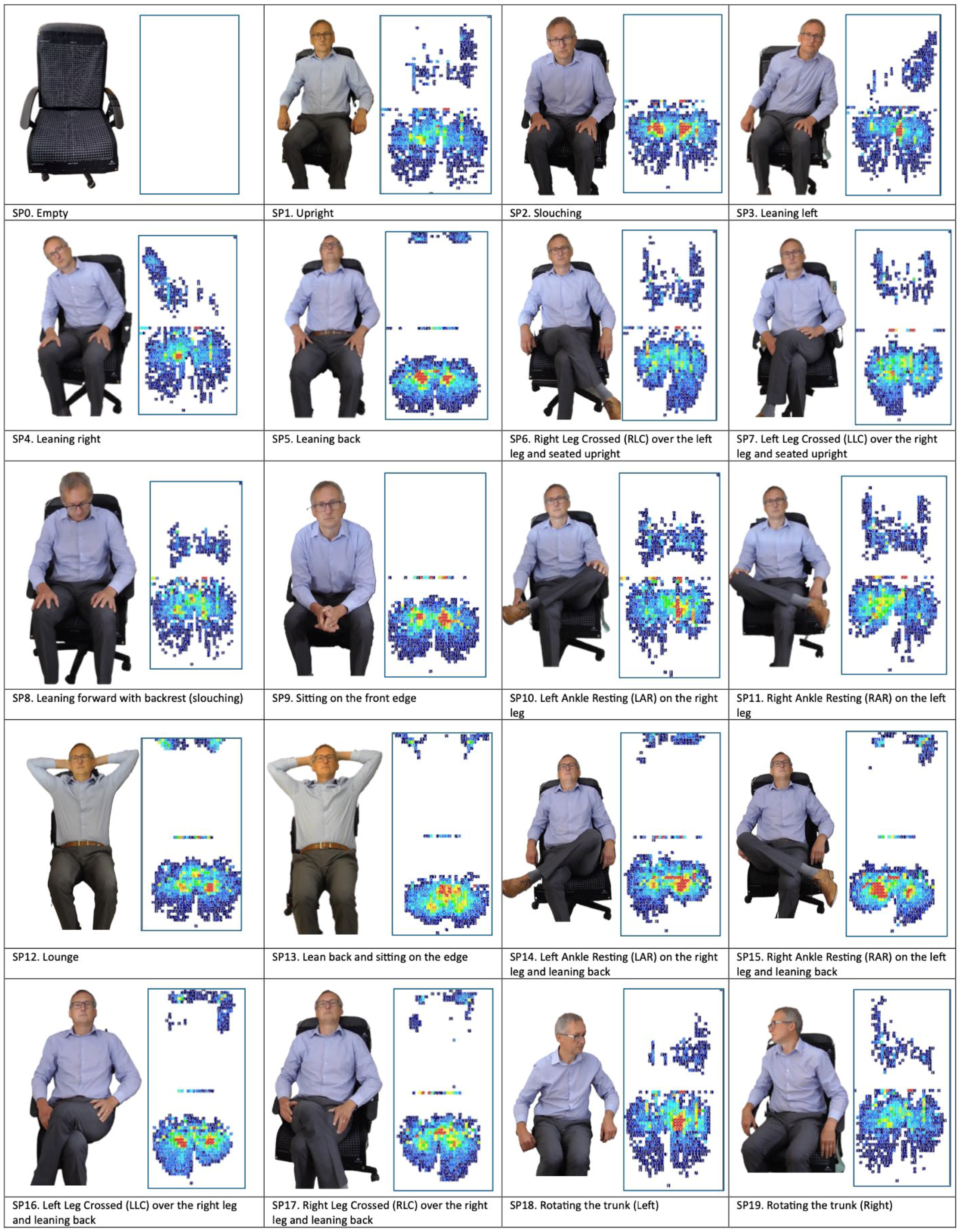




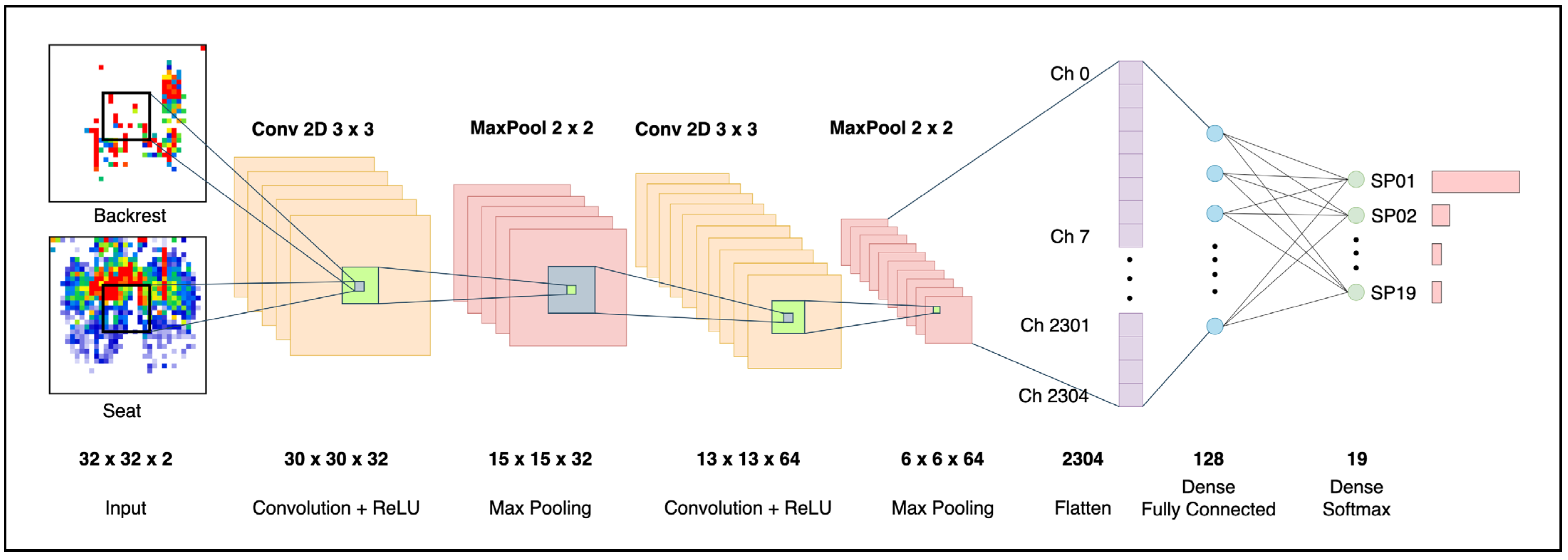

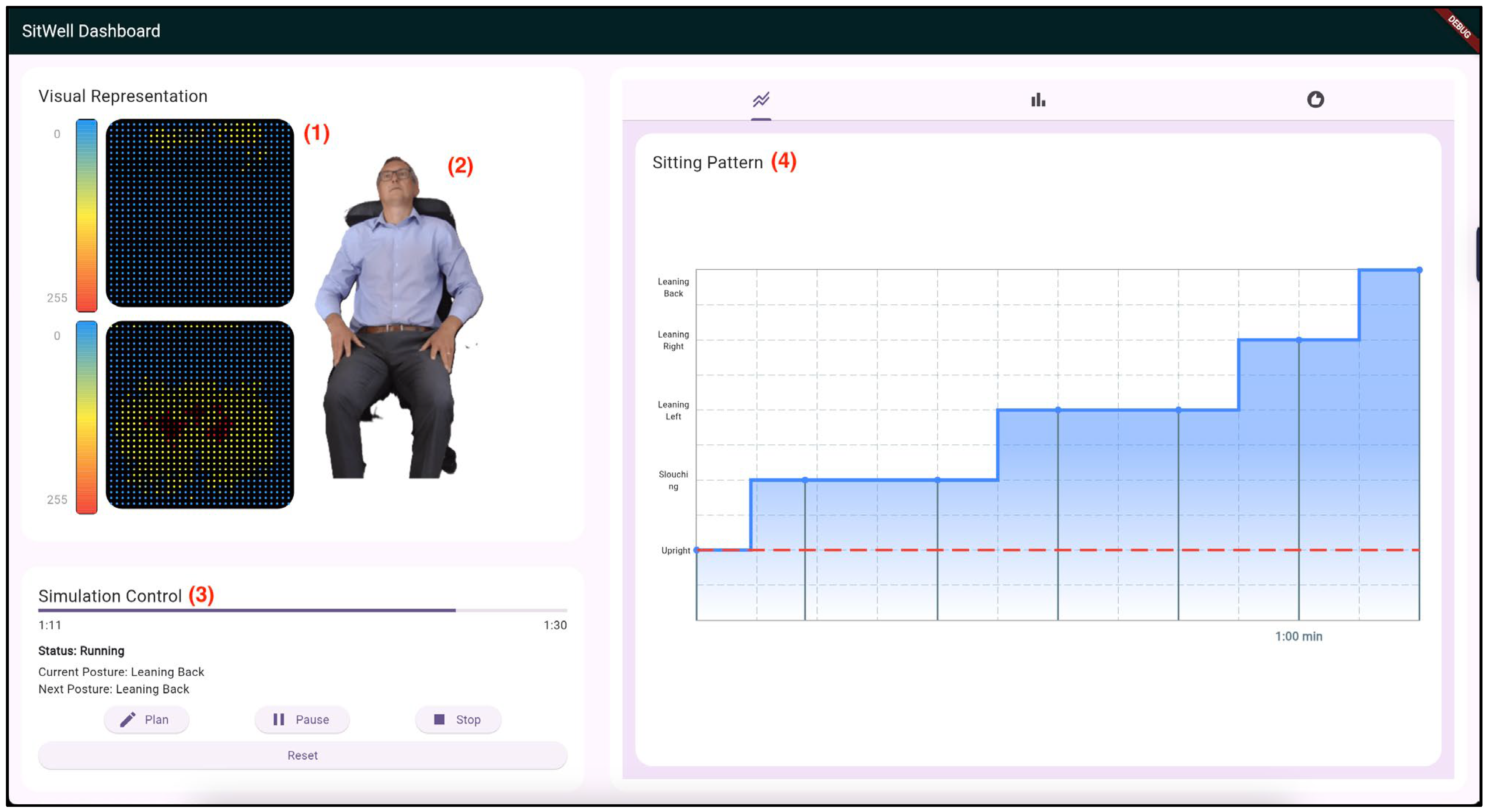
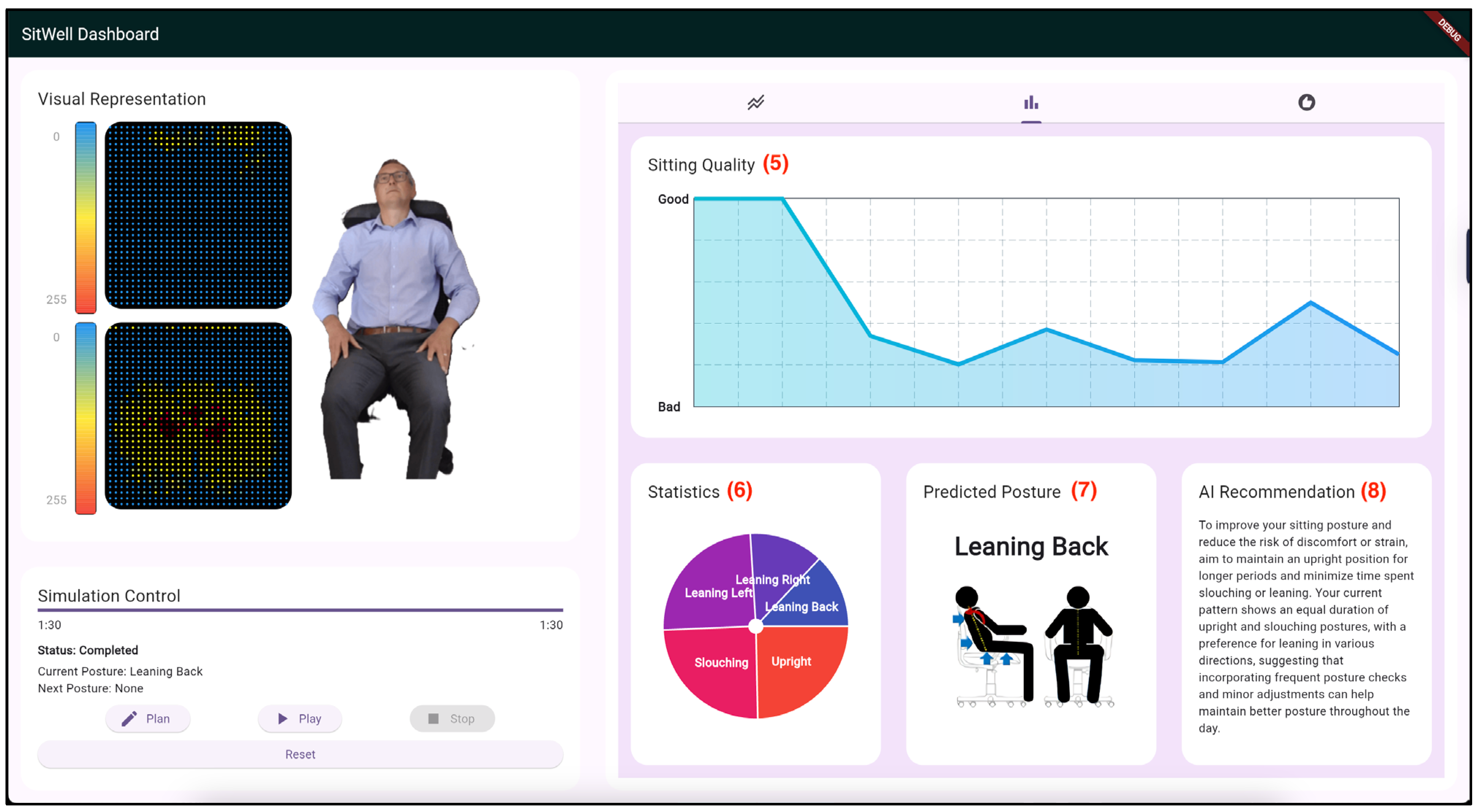

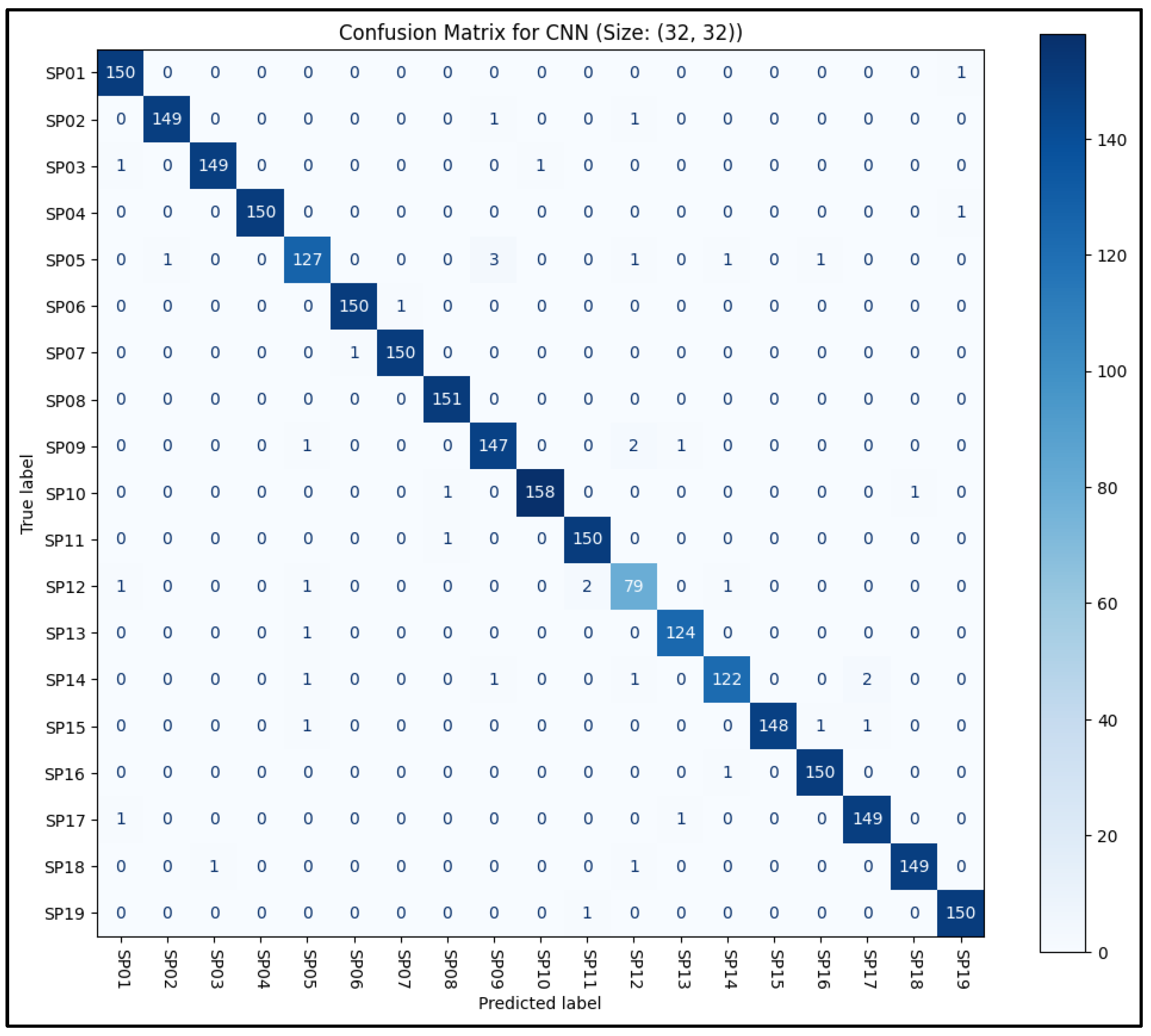
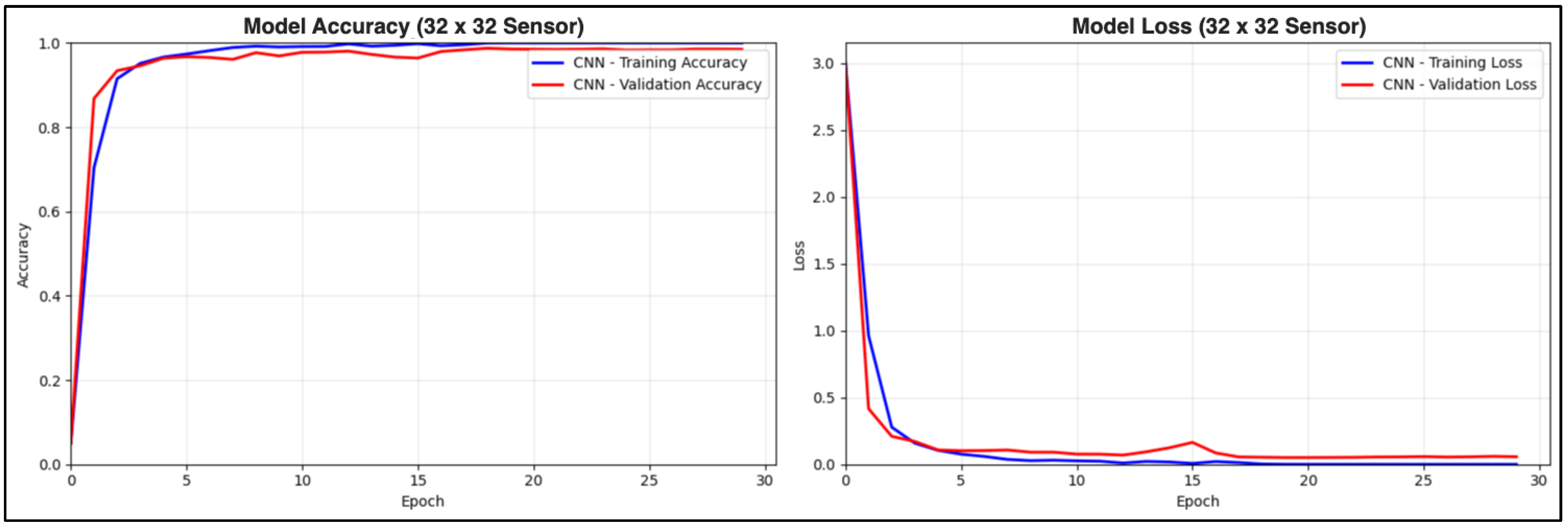
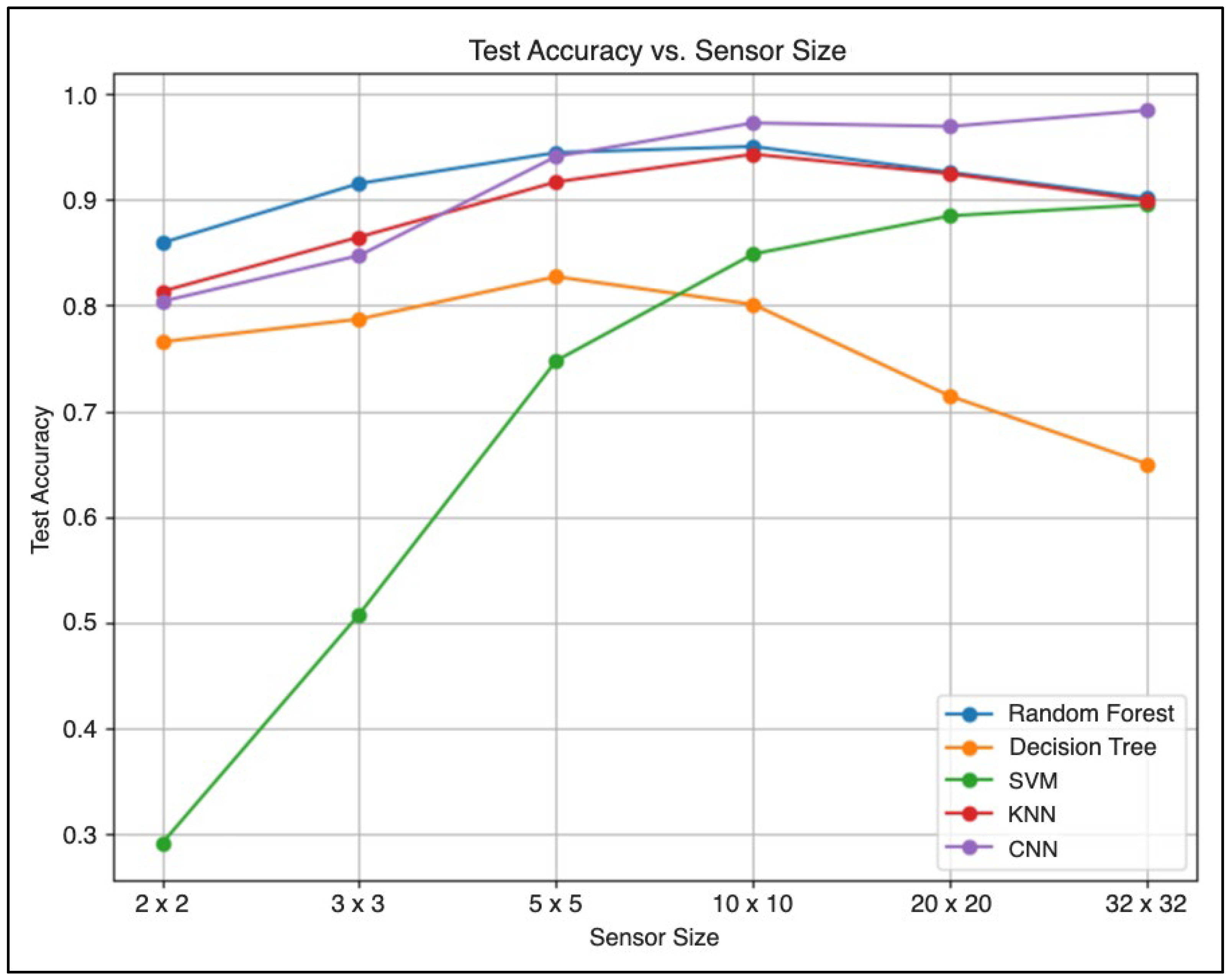

| Technical Specification | Details |
|---|---|
| System Model | CER2 (CONFORMat Sensor) |
| Sensor Model | 5330 |
| Quantity | 2 |
| Sensing Area | 471.4 mm × 471.4 mm (18.56 in. × 18.56 in.) |
| Number of Sensing Elements | 2048 (1024 on each mat) |
| Pressure Range | 0-34 kPa (5 psi) |
| Spatial Resolution | 0.5 Sensel/cm2 (3.0 Sensels/in2) |
| Sampling Rate | Up to 100 Hz |
| Transformation | Parameters |
|---|---|
| Noise | Gaussian Noise (noise level = 0.5) |
| Shift | x-shift = ±10 pixels y-shift = ±10 pixels |
| Rotation | ±30 degrees |
| Random Erasing | area = 10% |
| Elastic Deformation | Alpha = 24, sigma = 4 |
| Parameter | Value |
|---|---|
| Model | GPT-4o |
| Temperature | 1 |
| Max Token | 256 |
| Top P | 1 |
| Friction Penalty | 0 |
| Presence Penalty | 0 |
| Posture | Score | Description | Scientific Justification |
|---|---|---|---|
| SP1 | 1 | Neutral spine, lumbar support, 90° hip/knee angles | Highest quality of sitting: preserves natural lordosis, minimal muscle activation [44]. |
| SP2 | 10 | Unsupported forward trunk flexion | Worst posture: increases intradiscal pressure, resulting in a rapid onset of low-back pain and fatigue [44,45]. |
| SP3 | 7 | Lateral trunk flexion/weight shift left | Asymmetrical posture induces pelvic obliquity, scoliosis risk; quality of sitting compromised by uneven load [46,47]. |
| SP4 | 7 | Lateral trunk flexion/weight shift right | Mirror of SP3: similar pelvic tilt and muscle imbalance [46,47]. |
| SP5 | 3 | Semi-recline (10–130°) with lumbar support | Reduces the spinal disc pressure, improves comfort, and recommended for breaks [48]. |
| SP6 | 8 | Right leg crossed over left thigh, torso upright | Elevates one hip, lateral rotation; degrades sitting symmetry and lumbar alignment [49,50]. |
| SP7 | 8 | Left leg crossed over right thigh, torso upright | Mirror of SP6: similar pelvic torsion and musculoskeletal strain [49,50]. |
| SP8 | 9 | Trunk flexion despite back support | Backrest fails to preserve lordosis; high risk of chronic discomfort [44,51]. |
| SP9 | 6 | Buttocks at seat edge, anterior pelvic tilt | Opens hip angle, engages core; moderate quality but fatiguing over time [52]. |
| SP10 | 7 | Left ankle on right knee, torso upright | Asymmetric leg cross; reduces sitting quality and induces rotational shear [49,53]. |
| SP11 | 7 | Right ankle on left knee, torso upright | Mirror of SP10; similar lateral tilt and discomfort [49,53]. |
| SP12 | 4 | Full back support, legs forward | Simulates supine; lowest spinal load; good recovery posture but not for work tasks [54]. |
| SP13 | 9 | Perch edge with back lean, no lumbar support | Combined perch and recline; significant instability and posterior tilt [44]. |
| SP14 | 10 | Left ankle on right knee with unsupported recline | Worst combined posture: maximal torsion and flexion harm [49]. |
| SP15 | 10 | Right ankle on left knee with unsupported recline | Mirror of SP14: carrying identical risks [49]. |
| SP16 | 10 | Right leg crossed with unsupported recline | Compound cross with slouching: highest spinal stress [44]. |
| SP17 | 10 | Left leg crossed with unsupported recline | Mirror of SP16: same risk level [44]. |
| SP18 | 8 | Torso twisted left, hips fixed | Sustained rotation; increases facet-joint shear and disc stress [51]. |
| SP19 | 8 | Torso twisted right, hips fixed | Mirror of SP18: similar rotational load [51]. |
| ID | Postural Context | Duration Condition | Decay Factor |
|---|---|---|---|
| 1 | Upright | T ≤ 30 min | 0.0 |
| 2 | Upright | T > 30 min | 0.005 |
| 3 | Not Upright | T ≤ 30 s | 0 |
| 4 | Not Upright | T > 30 s | 0.02 |
| Model | Parameters | Accuracy | F1-Score | Precision | Recall |
|---|---|---|---|---|---|
| DT | depth = 30 | 0.6629 | 0.6615 | 0.6652 | 0.6578 |
| RF | depth = 30, n_estimator = 200 | 0.9027 | 0.9012 | 0.9078 | 0.8947 |
| SVM | C = 0.1 | 0.8969 | 0.8949 | 0.8967 | 0.8931 |
| KNN | k = 3 neighbors | 0.9103 | 0.9113 | 0.9210 | 0.9020 |
| CNN | epoch = 23 | 0.9829 | 0.9818 | 0.9823 | 0.9814 |
Disclaimer/Publisher’s Note: The statements, opinions and data contained in all publications are solely those of the individual author(s) and contributor(s) and not of MDPI and/or the editor(s). MDPI and/or the editor(s) disclaim responsibility for any injury to people or property resulting from any ideas, methods, instructions or products referred to in the content. |
© 2025 by the authors. Licensee MDPI, Basel, Switzerland. This article is an open access article distributed under the terms and conditions of the Creative Commons Attribution (CC BY) license (https://creativecommons.org/licenses/by/4.0/).
Share and Cite
Odesola, D.F.; Kulon, J.; Verghese, S.; Partlow, A.; Gibson, C. A Smart System for Continuous Sitting Posture Monitoring, Assessment, and Personalized Feedback. Sensors 2025, 25, 5610. https://doi.org/10.3390/s25185610
Odesola DF, Kulon J, Verghese S, Partlow A, Gibson C. A Smart System for Continuous Sitting Posture Monitoring, Assessment, and Personalized Feedback. Sensors. 2025; 25(18):5610. https://doi.org/10.3390/s25185610
Chicago/Turabian StyleOdesola, David Faith, Janusz Kulon, Shiny Verghese, Adam Partlow, and Colin Gibson. 2025. "A Smart System for Continuous Sitting Posture Monitoring, Assessment, and Personalized Feedback" Sensors 25, no. 18: 5610. https://doi.org/10.3390/s25185610
APA StyleOdesola, D. F., Kulon, J., Verghese, S., Partlow, A., & Gibson, C. (2025). A Smart System for Continuous Sitting Posture Monitoring, Assessment, and Personalized Feedback. Sensors, 25(18), 5610. https://doi.org/10.3390/s25185610








